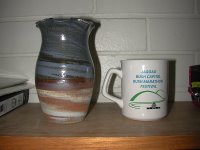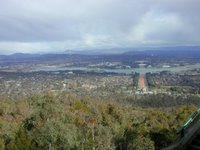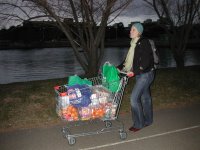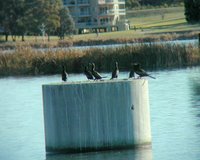Today was fun. It started out by me sleeping in until almost 9:00 after going to bed at a reasonable hour. My sinuses were a little sore and congested again this morning, which stunk. They got a little better thoughout the day, but still don't feel like they're healing too much. There's quite a few people around with colds, and I guess it's just that time of year here down under. Hopefully I'll feel all better soon though. Fortunately it's not too terrible in the meantime.
Anyway, around 10:15 AM I met up with Jamie from Colorado and we set off to explore Canberra with the dual purpose of searching for and shopping at Salvation Army thrift stores and visiting tourist attractions. We s

tarted by walking around Belconnen and locating the local Salvos (Salvation Army) store. We shopped there for a bit, and Jamie got some Fiji shot glasses for gifts (only 50 cents each!) and I almost bought a pair of pants that were size 82. I don't know how they do their sizes here, but I can tell you I certainly did NOT gain that much weight yet, so don't worry guys. :-P After Salvos we visited another thrift store around the corner, then walked over to the Belconnen bus interchange.
At the bus interchange we studied the large map of the routes for the Canberra Action bus service and determined that bus number 56 was the one that we needed to take in order to get to Mitchell, which is where another Salvos store is located. We waited on the bench for about 10 minutes or so before our bus arrived, and then were off toward Mitchell. This time we knew where the bus stops were, and were pretty sure we knew where the Salvos was. When we approach

ed the store I pressed the cool little "stop" button by my seat to signal the driver to stop at the next stop, which was about a half block from the store. Right next to the thrift store there was a pet shop and we both really wanted to go in and see what they had. It turned out to be one of the best pet shops either of us had ever been in, and it was amazing! They had a "tropical fish room" which was heated to a much warmer temperature than the rest of the store, and contained many different types of tropical fishes. There were also long-necked turtles and short-necked turtles, both of which looked really cool.
In another separate room of the store there were birds. We entered the bird room and it was the most amazing bird room we'd ever seen! ALL of the birds were in big aviaries and flight cages, and there were many birds of a variety of different types and colors. All of the aviaries had several tiny button quail in the bottom, and there were separate flights for finches, canaries, cockatiels, parakeets, smaller parrots, quaker parrots, and several types of larger parrots. Some of the smaller parrots were some of the most beautiful birds I had ever seen, and I managed to get some photos of them through the cage bars. I wanted to get one of the most colorful ones - yellow, green, blue, red, and orange all on one bird! It was such a striking bird! Unfortunately we cannot have any pets in the

dorms here on campus, so I had to settle for just some photos. Scattered throughout the rest of the store were a few rainbow lorrikeets, a big sulphur-crested cockatoo, and a rather dull-colored galah that was very affectionate and wanted me to pet it.
After exploring the pet store we shopped for a bit in the salvos store next door, and then waited on the curb for about 15 minutes the bus to come back by. We caught the bus again and rode it to the end of the line at the city centre bus exchange. We got off here and then walked a block to a subway, ordered foot-long sandwiches, then walked into the food court of the canberra centre mall to eat. I got a foot-long veggie delite sandwich and had the bread and cheese toasted, and I must say it was one of the best sandwiches I've ever eaten! After we were done eating we moved on, walking outside over the bridge across Lake Burley Griffin, and up Parliament Hill to the parliament house. At one point the sidewalk was pretty close to parliament house but it went away from our destination, so we cut up over a hill and over part of the lawn of the parliament house, which saved quite a lot of time.
After taking some pictures from outside, we went into the parliament house and picked up a couple of pamphlets, asked about tours, then followed directions and took a lift (elevator) to the roof. We were able to go up onto the roof and see the 360 degree view of the surrounding area. It was interesting that there was grass o

n the roof, and even some patio tables and chairs. You could see the straight landscaped view from the roof to the old parliament house, across lake burley griffin, and to the Australian War Memorial. Canberra was an engineered city, so it was pretty neat being able to see so far in a straight line that was a planned part of the architecture. On top of the roof of the parliament house there is an enormous metal structure that we learned was one of the largest steel structures in the world, and which held the Australian flag erected on top.
After exploring the roof of the parliament house, we went back down to the first floor and waited in a gallery for the tour to begin. During the tour we learned many interesting things about the history of Australian government and the city of Canberra, and all of the symbolism that was incorporated into the construction of the new parliament house. It was interesting to learn about the origins of Canberra, for example. It turns out that during the early 1900s parliamentary meetings were held in Melbou

rne, Australia. Later on though, Sydney wished to be the capital of Australia, and Belbourne did not want to give up the privilage of being the city where national governmental meetings were held. To compromise, the Australians decided that a new location in between the two cities would be chosen for the nation's capital. Canberra was eventually chosen as an intermediate location, and plans were made to make this place be the capital. Before it could become the capital, however, it was necessary for a city to be built, since there was at that time no city where Canberra is today. What then occurred was an international competition to design a city for Australia's capital. Eventually the winning design of the competition was chosen to be that of Walter Burley Griffin, a landscape architect from Chicago. It is interesting to note that due the fact that Canberra was designed and completely planned, it developed much unlike any other city, and the location and structure of main roads, commercial areas, suburbs, etc. were all determined prior to actually being created.
The city eventually built and old parliament house began being used for the first time in 1927. Over the years, however, several extensions were added to parliament house, and eventually the building still became too small. It was then decided that a new parliament house must be built, and that this new parliament house must be big enough
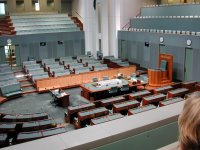
to become a permanent parliament house. Once again, Australia held an international competition for the design of the new parliament house. This time several hundred designs from people in over 30 countries were submitted. This time again, the winning entry was submitted by an American, although an Australian architect and a third guy from Europe were also very influential in the designing and construction of the new parliament house.
Because Walter Burley Griffin viewed the natural lay of the land to be a very important part of his design of Canberra, it was decided that they would do their best to build this large new building without significantly altering the landscape. What they did then, was, instead of building a large imposing building on top of parliament hill, they actually removed an equivalent of 125,000 semi loads of soil from the top of the hill, and then built the building where the hill had been. After the building had been constructed, they then brought back much of the dirt that they had removed and essentially "put the hill ba

ck". We found out that this is the reason why there was grass growing on the roof of the parliament house, for example. The building also has many sky lights and windows, which were designed to allow a maximum amount of natural light into the building.
We learned many other interesting facts about the parliament house and how the Australian government works on the tour. We learned that there are several different buildings that make up Parliament house, and they are all connected by glass-encased "catwalks". The whole complex contains a total of 17 different courtyards, and over 4,700 rooms! There are also several thousand clocks throughout the parliament house, and when they vote on a bill in the house or senate, there is a light on the clocks that flashes for four minutes, the precise amount of time everyone has to get to the house or senate in order to cast their vote. Also, after a senator spoke for over 12 hours once to prevent a vote from occuring before some of his colleagues got to parliament (back before transportation was great), they came up with a rule that would stop future filibusters

from occuring - no senator can speak for more than 20 minutes. They have a "speaking clock" in the senate that counts down from 20, and after 20 minutes is up if the senator is not yet done speaking, his microphone is cut off.
We learned also about how a lot of symbolism is incorporated into the buildings that make up the parliament house. For example, the house of representatives is green, and the senate is red -- just like the similar governmental meeting places in England. One difference, however, is to make it more Australian shades of green in the house of representatives were chosen to represent eucalyptus leaves, and the red of the senate was chosen to closely represent the pinkish red color of eucalyptus flowers. We also learned about a lot of symbolism in the largest room in parliament house (used for many functions, holds up to 1700 people). For example, the beautiful wood floors and most of the wood in the rest of that room is native-grown Australian timber. The different colored timber had different symbolism that it represented. There is also an enormous tapestry along the one wall in that room, the second-largest tapestry in the world (I believe the lady said England has the biggest one). The design for the tapestry was designed by commissioning an Australian artist. There was a lot of symbolism incorporated into the original painting of things that represent Australian culture and life. There was even a bird (a sulphur-crested cockatoo) incorporated into the painting. After th
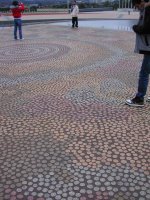
e huge painting was created, a much larger (sixteen times bigger!) tapestry was created by commissioning ummm.. people that make tapestries I guess. It took a while to create, but eventually a replica of the original painting was woven out of wool, linen, and other fibers using 360 different colors!
More symbolism was encountered in the main room just inside the entrance of the parliament house. For example, the marble pillars and staircases were made from different colored marble (green and pink) imported from European countries that had a significant influence on Australia's culture and development. Aside from this, nearly all of the materials for the rest of the building were produced in Australia. Outside the main entrance to the parliament house the red stone also had symbolism, and a large picture made out of stones in the ground was created by an aboriginal artist, and symbolizes the coming together of everyone in Australia to a common place.
By the time the tour ended and we were done exploring parliament house it was after 4:00 and Jamie and I decided to head back to UC since it would soon be dark. We caught a ride on another bus that took us back to the Belconnen bus

interchange and then walked back to the dorm from there. I actually found all of this information that I learned today quite interesting, and I hope I didn't bore too many people by filling you in with the details. I never knew much at all about Australia or its government before this trip. I didn't even know what the capital of Australia was until I started researching where I was going to go this semester. I had never even heard of Canberra before this trip! Apparently most Americans and even some Australians think that Sydney is the capital of Australia. Now everyone that reads my blog knows the truth. :)
